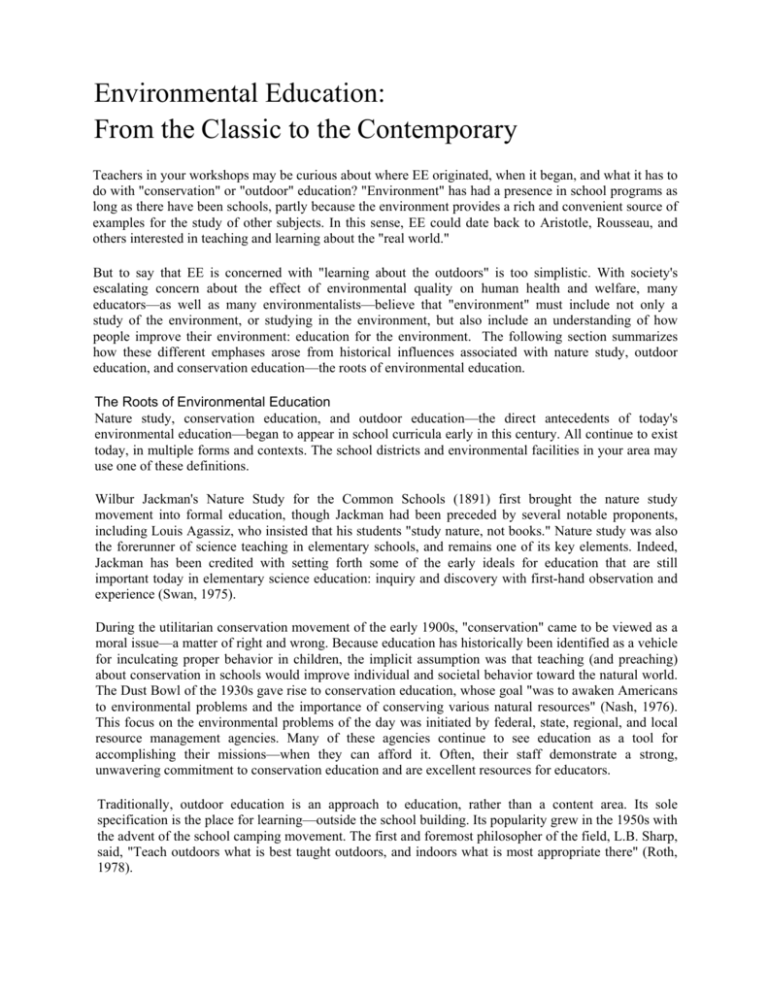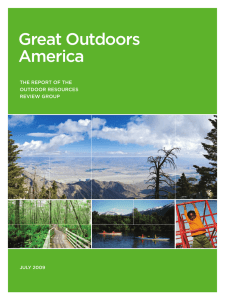conservation education and are excellent resources for educators
advertisement

Environmental Education: From the Classic to the Contemporary Teachers in your workshops may be curious about where EE originated, when it began, and what it has to do with "conservation" or "outdoor" education? "Environment" has had a presence in school programs as long as there have been schools, partly because the environment provides a rich and convenient source of examples for the study of other subjects. In this sense, EE could date back to Aristotle, Rousseau, and others interested in teaching and learning about the "real world." But to say that EE is concerned with "learning about the outdoors" is too simplistic. With society's escalating concern about the effect of environmental quality on human health and welfare, many educators—as well as many environmentalists—believe that "environment" must include not only a study of the environment, or studying in the environment, but also include an understanding of how people improve their environment: education for the environment. The following section summarizes how these different emphases arose from historical influences associated with nature study, outdoor education, and conservation education—the roots of environmental education. The Roots of Environmental Education Nature study, conservation education, and outdoor education—the direct antecedents of today's environmental education—began to appear in school curricula early in this century. All continue to exist today, in multiple forms and contexts. The school districts and environmental facilities in your area may use one of these definitions. Wilbur Jackman's Nature Study for the Common Schools (1891) first brought the nature study movement into formal education, though Jackman had been preceded by several notable proponents, including Louis Agassiz, who insisted that his students "study nature, not books." Nature study was also the forerunner of science teaching in elementary schools, and remains one of its key elements. Indeed, Jackman has been credited with setting forth some of the early ideals for education that are still important today in elementary science education: inquiry and discovery with first-hand observation and experience (Swan, 1975). During the utilitarian conservation movement of the early 1900s, "conservation" came to be viewed as a moral issue—a matter of right and wrong. Because education has historically been identified as a vehicle for inculcating proper behavior in children, the implicit assumption was that teaching (and preaching) about conservation in schools would improve individual and societal behavior toward the natural world. The Dust Bowl of the 1930s gave rise to conservation education, whose goal "was to awaken Americans to environmental problems and the importance of conserving various natural resources" (Nash, 1976). This focus on the environmental problems of the day was initiated by federal, state, regional, and local resource management agencies. Many of these agencies continue to see education as a tool for accomplishing their missions—when they can afford it. Often, their staff demonstrate a strong, unwavering commitment to conservation education and are excellent resources for educators. Traditionally, outdoor education is an approach to education, rather than a content area. Its sole specification is the place for learning—outside the school building. Its popularity grew in the 1950s with the advent of the school camping movement. The first and foremost philosopher of the field, L.B. Sharp, said, "Teach outdoors what is best taught outdoors, and indoors what is most appropriate there" (Roth, 1978). Outdoor education has been described as a potential vehicle for all subjects of the curriculum, among them art, music, science, mathematics, and English. Specialists in this area often make use of school yards and become involved in local community studies, but usually emphasize residential camp programs. In addition to an extended hike, a pond study, or a forestry exercise (activities that are also nature study and conservation education), outdoor educators often add living history lessons on pioneer and, Native American life, cooperative group challenges, or ropes courses. Societal Influences and Trends The progressive education movement of the 1930s was another significant strand in the evolution of environmental education. Led by John Dewey, it advocated a child-centered and holistic approach to learning, making education more responsive to the needs of children. The focus of progressive education was "learning by doing," which incorporated learning about the environment while in the environment. It also encouraged holistic, integrated, interdisciplinary education. Progressive educators believed that education was more than preparation for life—it was a significant aspect of life. The physical and social environment between 1950 and 1970 helped create a fertile ground for environmental education to grow from these earlier educational roots into a unique entity. After World War II, science and technology played a stronger role in establishing new expectations for a "quality of life," global communication improved, and the world's population increase exponentially. Calls for education dealing with the environment became increasingly more persistent after the 1962 publication of Silent Spring (Carson, 1962), commonly identified as the event that triggered the environmental movement of the 1960s and 1970s. Adlai Stevenson's term "spaceship earth," was another graphic statement that helped people realize the powerful impact humans can have on the environment (Swan, 1975). This environmental movement differed from earlier 20th century conservation movements because it "...was far more widespread and popular, involving public values that stressed the quality of the human experience and hence of the human environment" (Hays, 1985, emphasis added). Frustrations over environmental catastrophes, such as the Santa Barbara oil spill and a burning river in Cleveland, were symbiotically interrelated with events in the social sphere. The civil rights marches and anti-war demonstrations represented a change in the way citizens viewed the rights and responsibilities of citizenship. No longer content to be passive voters, the tumultuous times gave the more expressive citizens and advocacy groups opportunities to speak (Caldwell, 1976). The 1970 Earth Day celebrations were a landmark expression of public support for a realignment of values and a new respect for the environment. During this period of environmental activism, the U.S. Environmental Protection Agency was created and numerous federal and state laws promoting environmental quality were enacted, prominent among them the 1969 National Environmental Policy Act and the 1970 National Environmental Education Act. Both identified education as a mechanism for improving the quality of the human environment. The recent 1990 National Environmental Education Act (PL. 101-619) reaffirms the purpose of the earlier act and focuses on schools as the place for effective environmental education, while recognizing the importance of non-formal avenues for educating citizens, communities, and the workforce.









